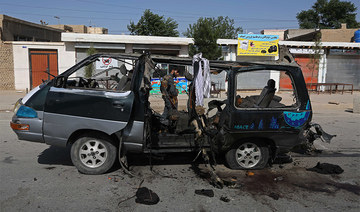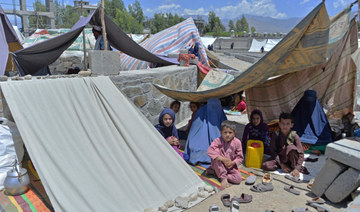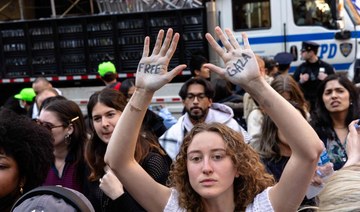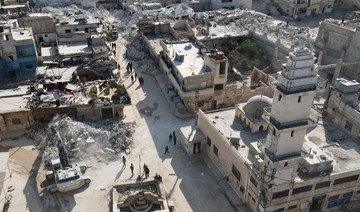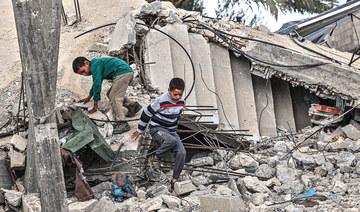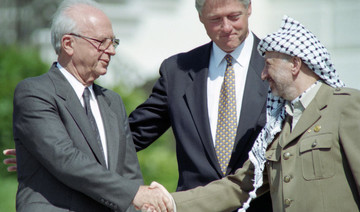KABUL: The Taliban have assured Afghans who worked with foreign forces of their safety, telling them not to flee the country as Western embassies process thousands of visa applications.
Few felt reassured as panic rises ahead of a troop withdrawal, however.
The insurgent group said on Monday Afghans who had worked as interpreters or in other roles would be safe so long as they “show remorse” for their past actions.
They must also not engage in activities which it said “amount to treason against Islam and the country.”
But as the clock ticks down to a final troop withdrawal deadline of Sept. 11 and fighting and killings rise around the country, the thousands of Afghans who have applied for visas to leave are becoming increasingly concerned.
“It is nothing but a lie, I don’t trust the Taliban...it is just a fake attempt to show a good image of their to the world,” said Babakarkhel, who asked to be identified by only one name.
He said he had worked with US forces in southeastern Afghanistan for six years.
“I am sure they will kill me, they will cut me into pieces if they catch me tomorrow.”
His visa has been in process for two years, he said.
Khan, who also asked his full name not be used, had worked as a translator for German forces in northern Afghanistan and has applied for a visa to Germany, said he constantly feared death from the Taliban and dreaded the withdrawal of troops while he waited for his visa.
“The Taliban hate us more than any others, calling us spies and traitors,” he said. “Nothing can change the Taliban’s’ mentality regarding us translators, which is our death...there is a big difference between the Taliban’s words and actions.”
US Secretary of State Antony Blinken told the US House Committee for Foreign Affairs on Monday there had been a backlog in cases and there were still about 18,000 applicants for the Special Immigrant Visas designed for those who had worked with US government forces and agencies.
Efforts were being made to speed things up, he said.
James Miervaldis, the Board Chairman of American non-profit No One Left Behind, which works with thousands of Afghan interpreters to help them get to the United States, said things were not moving fast enough.
“We’re very concerned. It’s good that things are happening, we just need them to happen faster. There’s real panic and fear across the board from every applicant.”
He said about two interpreters a month had been killed this year, but the figure rose to about five last month. Other interpreters were receiving threatening letters from the Taliban.
There was widespread mistrust of the Taliban’s assurances of safety, he said. “Nobody’s buying it.”
The Taliban did not respond to a request for comment on the threats and killings faced by interpreters.
The US State Department said it was still committed to resettling Afghans who had worked with the US government, and was troubled by the killings of non-combatants.
While it welcomed the Taliban’s statement, “We will not be reassured until all targeted attacks on civilians stop,” a State Department spokesperson said.
Fighting has increased across Afghanistan as the United States and more than 20 allied countries withdraw, ending a two-decade presence since the Taliban were forced from power in the wake of the 9/11 attacks on the United States. Political talks between the government and the Taliban have largely stalled.
Taliban assures safety of Afghans who worked with foreign forces, but few believe them
https://arab.news/pwjbb
Taliban assures safety of Afghans who worked with foreign forces, but few believe them
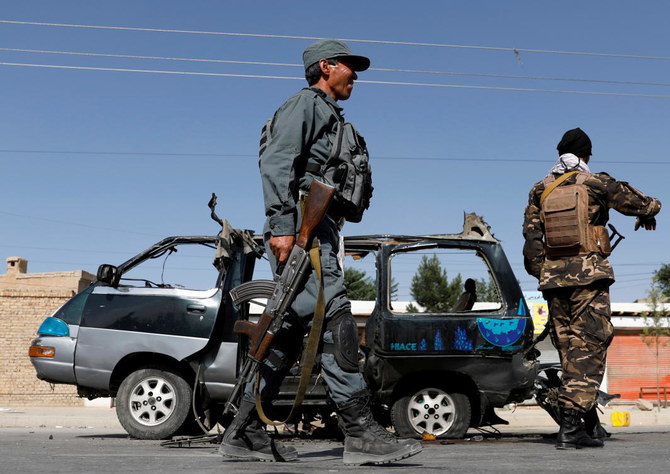
- Insurgent group said Afghans, who had worked as interpreters or in other roles would be safe so long as they "show remorse" for their past actions
- "They will cut me into pieces if they catch me tomorrow,” said an Afghan who worked with foreign forces
Anti-war protest ruffles University of Michigan as demonstrations collide with graduation season

- Israel has killed more than 34,000 Palestinians, according to Gaza’s Health Ministry
- Tent encampments of protesters calling on universities to stop doing business with Israel or companies they say support the war in Gaza have spread across campuses nationwide in recent weeks in a student movement unlike any other this century
NEW YORK: Protesters chanted anti-war messages and waved Palestinian flags during the University of Michigan’s commencement Saturday, as student demonstrations against the Israel-Hamas war collided with the annual pomp-and-circumstance of graduation season at American universities.
The protest happened at the beginning of the event at Michigan Stadium in Ann Arbor. About 75 people, many wearing traditional Arabic keffiyeh along with their graduation caps, marched up the main aisle toward the graduation stage.
They chanted “Regents, regents, you can’t hide! You are funding genocide!” while holding signs, including one that read: “No universities left in Gaza.”
Overhead, planes flew competing messages. One read: “Divest from Israel now! Free Palestine!” The other read: “We stand with Israel. Jewish lives matter.”
Officials said no one was arrested, and the protest didn’t seriously interrupt the nearly two-hour event, which was attended by tens of thousands of people, some of them waving Israeli flags.
State police prevented the demonstrators from reaching the stage and university spokesperson Colleen Mastony said public safety personnel escorted the protesters to the rear of the stadium, where they remained through the conclusion of the event.
“Peaceful protests like this have taken place at U-M commencement ceremonies for decades,” she added.
US Navy Secretary Carlos Del Toro paused a few times during his remarks, saying at one point, “Ladies and gentlemen, if you can please draw your attention back to the podium.”
Before he administered an oath to graduates in the armed forces, Del Toro said they would “protect the freedoms that we so cherish,” including the “right to protest peacefully.”
The university has allowed protesters to set up an encampment on campus but police assisted in breaking up a large gathering at a graduation-related event Friday night, and one person was arrested.
Michigan was among the schools bracing for protests during its commencement ceremonies this weekend, including Indiana University, Ohio State University and Northeastern University in Boston. Many more are slated in the coming weeks.
At Indiana University, protesters were urging supporters to wear their keffiyehs and walk out during remarks by President Pamela Whitten on Saturday evening. The campus in Bloomington, Indiana, has designated a protest zone outside Memorial Stadium, where the ceremony is set to take place.
Tent encampments of protesters calling on universities to stop doing business with Israel or companies they say support the war in Gaza have spread across campuses nationwide in recent weeks in a student movement unlike any other this century. Some schools have reached agreements with the protesters to end the demonstrations and reduce the possibility of disrupting final exams and commencements.
Many encampments have been dismantled and protesters arrested in police crackdowns.
The Associated Press has recorded at least 61 incidents since April 18 where arrests were made at campus protests across the US More than 2,400 people have been arrested on 47 college and university campuses. The figures are based on AP reporting and statements from universities and law enforcement agencies.
At Princeton, in New Jersey, 18 students launched a hunger strike in an effort to push the university to divest from companies tied to Israel.
Senior David Chmielewski, a hunger striker, said in an email Saturday that the latest protest started Friday morning with participants consuming water only.
He said the hunger strike will continue until university administrators meet with students about their demands, which include amnesty from criminal and disciplinary charges for protesters.
Other demonstrators are participating in “solidarity fasts” lasting 24 hours, he said.
Princeton students set up a protest encampment and some held a sit-in at an administrative building this week, leading to about 15 arrests.
Students at other colleges, including Brown and Yale, launched similar hunger strikes earlier this year before the more recent wave of protest encampments.
In other developments Saturday, police broke up a demonstration at the University of Virginia. Campus police called it an “unlawful assembly” in a post on the social platform X.
Footage from WVAW-TV showed police wearing tactical gear removing protesters from an encampment on the Charlottesville campus. Authorities have not said how many people were arrested.
Meanwhile near Boston, students at Tufts University peacefully took down their protest encampment without police intervention Friday night.
Officials with the school in Medford, Massachusetts, said they were pleased with the development, which wasn’t the result of any agreement with protesters. Protest organizers said in a statement that they were “deeply angered and disappointed” that negotiations with the university had failed.
The protests stem from the Israel-Hamas conflict that started on Oct. 7 when Hamas militants attacked southern Israel, killing about 1,200 people, mostly civilians, and taking roughly 250 hostages.
Vowing to destroy Hamas, Israel launched an offensive in Gaza that has killed more than 34,500 Palestinians, around two-thirds of them women and children, according to the Health Ministry in the Hamas-ruled territory. Israeli strikes have devastated the enclave and displaced most of Gaza’s inhabitants.
Warren Buffett says AI may be better for scammers than society. And he’s seen how

- The billionaire investing guru predicted scammers will seize on the technology, and may do more harm with it than society can wring good
OMAHA, Nebraska: Warren Buffett cautioned the tens of thousands of shareholders who packed an arena for his annual meeting that artificial intelligence scams could become “the growth industry of all time.”
Doubling down on his cautionary words from last year, Buffett told the throngs he recently came face to face with the downside of AI. And it looked and sounded just like him. Someone made a fake video of Buffett, apparently convincing enough that the so-called Oracle of Omaha himself said he could imagine it tricking him into sending money overseas.
The billionaire investing guru predicted scammers will seize on the technology, and may do more harm with it than society can wring good.
“As someone who doesn’t understand a damn thing about it, it has enormous potential for good and enormous potential for harm and I just don’t know how that plays out,” he said.
EARNINGS BEFORE MUSINGS
The day started early Saturday with Berkshire Hathaway announcing a steep drop in earnings as the paper value of its investments plummeted and it pared its Apple holdings. The company reported a $12.7 billion profit, or $8.825 per Class A share, in first the quarter, down 64 percent from $35.5 billion, or $24,377 per A share a year ago.
But Buffett encourages investors to pay more attention to the conglomerate’s operating earnings from the companies it actually owns. Those jumped 39 percent to $11.222 billion, or $7,796.47 per Class A share, led by insurance companies’ performance.
None of it that got in the way of the fun.
Throngs flooded the arena to buy up Squishmallows of Buffett and former Vice Chairman Charlie Munger, who died last fall. The event attracts investors from all over the world and is unlike any other company meeting. Those attending for the first time are driven by an urgency to get here while the 93-year-old Buffett is still alive.
“This is one of the best events in the world to learn about investing. To learn from the gods of the industry,” said Akshay Bhansali, who spent the better part of two days traveling from India to Omaha.
A NOTABLE ABSENCE
Devotees come from all over the world to vacuum up tidbits of wisdom from Buffett, who famously dubbed the meeting ‘Woodstock for Capitalists.’
But a key ingredient was missing this year: It was the first meeting since Munger died.
The meeting opened with a video tribute highlighting some of his best known quotes, including classic lines like “If people weren’t so often wrong, we wouldn’t be so rich.” The video also featured skits the investors made with Hollywood stars over the years, including a “Desperate Housewives” spoof where one of the women introduced Munger as her boyfriend and another in which actress Jaimie Lee Curtis swooned over him.
As the video ended, the arena erupted in a prolonged standing ovation honoring Munger, whom Buffett called “the architect of Berkshire Hathaway.”
Buffett said Munger remained curious about the world up until the end of his life at 99, hosting dinner parties, meeting with people and holding regular Zoom calls.
“Like his hero Ben Franklin, Charlie wanted to understand everything,” Buffett said.
For decades, Munger and Buffett functioned as a classic comedy duo, with Buffett offering lengthy setups to Munger’s witty one-liners. He once referred to unproven Internet companies as “turds.”
Together, the pair transformed Berkshire from a floundering textile mill into a massive conglomerate made up of a variety of interests, from insurance companies such as Geico to BNSF railroad to several major utilities and an assortment of other companies.
Munger often summed up the key Berkshire’s success as “trying to be consistently not stupid, instead of trying to be very intelligent.” He and Buffett also were known for sticking to businesses they understood well.
“Warren always did at least 80 percent of the talking. But Charlie was a great foil,” said Stansberry Research analyst Whitney Tilson, who was looking forward to his 27th consecutive meeting.
NEXT GEN LEADERS
Munger’s absence, however, created space for shareholders to get to know better the two executives who directly oversee Berkshire’s companies: Ajit Jain, who manages the insurance units; and Abel, who handles everything else and has been named Buffett’s successor. The two shared the main stage with Buffett this year.
The first time Buffett kicked a question to Abel, he mistakenly said “Charlie?” Abel shrugged off the mistake and dove into the challenges utilities face from the increased risk of wildfires and some regulators’ reluctance to let them collect a reasonable profit.
Morningstar analyst Greggory Warren said he believes Abel spoke up more Saturday and let shareholders see some of the brilliance Berkshire executives talk about.
“Greg’s a rock star,” said Chris Bloomstran, president of Semper Augustus Investments Group. “The bench is deep. He won’t have the same humor at the meeting. But I think we all come here to get a reminder every year to be rational.”
A LOOK TO THE FUTURE
Buffett has made clear that Abel will be Berkshire’s next CEO, but he said Saturday that he had changed his opinion on how the company’s investment portfolio should be handled. He had previously said it would fall to two investment managers who handle small chunks of the portfolio now. On Saturday, Buffett endorsed Abel for the gig, as well as overseeing the operating businesses and any acquisitions.
“He understands businesses extremely well. and if you understand businesses, you understand common stocks,” Buffett said. Ultimately, it will be up to the board to decide, but the billionaire said he might come back and haunt them if they try to do it differently.
Overall, Buffett said Berkshire’s system of having all the noninsurance companies report to Abel and the insurers report to Jain is working well. He himself hardly gets any calls from managers anymore because they get more guidance from Abel and Jain.
“This place would work extremely well the next day if something happened to me,” Buffett said.
Nevertheless, the best applause line of the day was Buffett’s closing remark: “I not only hope that you come next year but I hope that I come next year.”
US blames Rwanda for deadly attack on displaced camp in DR Congo

- DR Congo government spokesman Patrick Muyaya on Friday had also accused “the Rwandan army and its M23 terrorist supporters” of being responsible in a statement on X, the former Twitter
WASHINGTON: The United States has accused Rwanda of involvement in a deadly attack on a camp for displaced people in the eastern Democratic Republic of Congo, a claim dismissed as “absurd” by Kigali on Saturday.
At least nine people were killed in blasts on Friday in the camp on the outskirts of the city of Goma, local sources said.
“The United States strongly condemns the attack (Friday) from Rwanda Defense Forces and M23 positions on the Mugunga camp for internally displaced persons in eastern Democratic Republic of the Congo,” State Department spokesman Matthew Miller said in a statement.
Miller said the United States was “gravely concerned” by the expansion in DR Congo of Rwandan forces and the M23, a mostly Tutsi group that resumed its armed campaign in the vast, long turbulent DR Congo in 2021.
“It is essential that all states respect each other’s sovereignty and territorial integrity and hold accountable all actors for human rights abuses in the conflict in eastern DRC,” he said.
DR Congo government spokesman Patrick Muyaya on Friday had also accused “the Rwandan army and its M23 terrorist supporters” of being responsible in a statement on X, the former Twitter.
Rwandan government spokesperson Yolande Makolo described the US comments as “ridiculous,” in a post on X.
“How do you come to this absurd conclusion? The RDF, a professional army, would never attack an IDP camp,” she said.
“Look to the lawless FDLR and Wazalendo supported by the FARDC (the Congolese armed forces), for this kind of atrocity,” she added.
The FDLR, or Democratic Forces for the Liberation of Rwanda, is an armed ethnic Hutu group operating in Congo’s east for 30 years, while Wazalendo is fighting the M23 alongside the Congolese army.
The origin of Friday’s blasts has not been clearly established.
According to witnesses, government forces positioned near the camp had been bombarding the rebels on hills further west since early morning and, according to a civil society activist, “the M23 retaliated by throwing bombs indiscriminately.”
“Horror in its most serious form! A bomb on civilians, deaths, children! A new war crime,” said the government spokesman Muyaya.
The United States has repeatedly backed Kinshasa’s claims that Rwanda has backed the M23, but Miller’s statement amounts to an unusually direct implication.
France’s President Emmanuel Macron also this week called on Rwanda to end its backing for M23 rebels and withdraw its troops from DR Congo territory.
President Paul Kagame in turn has demanded that the DR Congo act against Hutu forces over ties with the perpetrators of Rwanda’s 1994 genocide, which mostly targeted Tutsis.
The United States has repeatedly sought to mediate between the two sides, with intelligence chief Avril Haines in November visiting DR Congo and Rwanda and announcing a pathway to reduce tensions.
Secretary of State Antony Blinken this year met Kagame and voiced hope that Rwanda was willing to engage in diplomacy.
Saudi Arabia’s on the frontline of battle against climate change
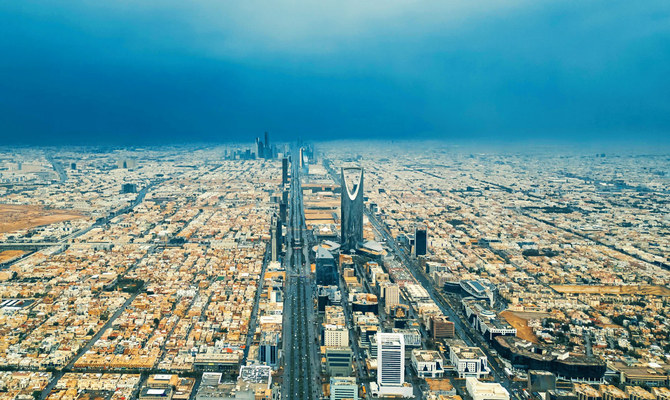
- Middle Eastern countries face unique challenges that compound the urgency of tackling this environmental crisis
RIYADH: As temperatures continue to rise worldwide, the Arab region is on the frontline of the battle against climate change.
In the global race to achieve net-zero, the Middle Eastern countries face unique challenges that compound the urgency of tackling this environmental crisis to safeguard their future.
The Gulf region is one of the areas most heavily impacted by climate change, primarily due to the already elevated temperatures that have exceeded the global average.
In recent years, the Arab world has heightened its focus on the ramifications of global warming, particularly its economic impacts, to avert the detrimental consequences.
Events such as MENA Climate Week in Riyadh in 2023, the UAE’s COP28 in 2023, and Egypt’s COP27 in 2022 underscore the region’s commitment to addressing this pressing issue.
Speaking to Arab News, Sal Jafar, CEO of ESG MENA, underscored these efforts, stating: “I have observed firsthand the transformative strides the GCC countries are making in the realm of energy transition and climate change efforts.”
He added: “This region, historically reliant on hydrocarbon economies, is now at the forefront of a pivotal shift toward sustainability and environmental stewardship, underpinned by an ESG framework.”
The intricate relationship between atmospheric changes and financial growth in these nations underscores the necessity of adopting sustainable development practices.
A recent report by the Arab Monetary Fund states that by the year 2050, the region may experience a significant reduction in water availability and agricultural productivity.
This decline, which is connected to climate-related water scarcity, could result in economic losses equivalent to 14 percent of the area’s gross domestic product.
Saudi Arabia, a pivotal player in the Middle East and a significant oil producer, embodies the region’s complexities and potential for transformation.
The Kingdom has been keen to amplify its efforts in energy transition for at least a decade, Yousef Al-Shammari, the CEO of CMarkits, a UK-based energy research consultancy firm, told Arab News.
These measures began with the launch of the King Abdullah City for Atomic and Renewable Energy in 2013, he noted, saying: “At that time, the aim was to minimize crude oil consumption by utilizing alternative sources of energy. Especially because the local consumption of crude is projected to keep rising because of national consumption of electricity and, of course, road transport demand.”

This region, historically reliant on hydrocarbon economies, is now at the forefront of a pivotal shift toward sustainability and environmental stewardship, underpinned by an ESG framework.
Sal Jafar, CEO of ESG MENA
Crude oil demand is projected to rise to as high as 8 million barrels per day, while the Kingdom produces 10 million barrels. This will inevitably lead to an “economic security risk” and result in the nation’s first motive of ensuring energy efficiency, Al-Shammari said.
However, with rising concerns about escalating temperatures and environmental sustainability, the nation launched its Vision 2030 in 2016 to position itself as a global leader in clean energy production and divert its economy from oil dependency.
The road to net-zero
The Kingdom has embarked on various initiatives to reduce its carbon footprint and diversify its economy beyond oil.
Mitigative efforts include ambitious targets of 44 million tonnes of carbon dioxide captured annually by 2035 and 2 million tonnes of CO2 seized and utilized daily to produce glycol, urea and green methanol, as well as clean fuels, according to the 14th IEA-IEF-OPEC Symposium on Energy Outlooks.
This is being made possible through the circular carbon initiative, which was introduced during the Kingdom’s presidency of the G20, the CEO highlighted, saying: “The circular carbon initiative that includes removal reduce, reuse, and recycle,” he explained, adding: “Saudi Aramco is pursuing a very ambitious program on that line. I think there is one major project, which is starting in 2027, which will be the world’s largest CO2 capture project.”
The facility, which Aramco is said to play a significant role in, seeks to capture 9 million tonnes per annum of CO2 by 2027, with the aim of increasing its capacity to 44 million tonnes per annum by 2035, Al-Shammari outlined.
In October of 2022, the Kingdom’s sovereign wealth fund launched its regional Voluntary Carbon Market company during the sixth edition of the Future Investment Initiative in Riyadh.
This move allowed for tradable CO2 shares to be launched on an exchange, with major players in the Saudi energy field, like Aramco and SABIC, taking part.
The idea of the VCM is to allow companies to pay to compensate for their CO2 emissions. Additionally, the market’s voluntary nature presents a greater chance for success than compulsory sectors implemented in other regions, Al-Shammari outlined.
He said: “It’s voluntary, which means it can have a bigger impact than compulsory carbon markets, which we have seen in Europe, which did not really lead to any carbon reductions. The idea is, by being voluntary, it essentially enables companies to make economic sense of it. So when you have an economic return by having these investments in carbon markets, that would pay off the cost of capturing carbon. So somehow, it encourages producers to minimize their carbon emissions.” He added: “There is so much research and literature that has been done on that and the optimism about the
voluntary market is so huge and encouraging producers to minimize emissions compared to the compulsory markets.”
Greening the world
Equipped with a strategic location at the crossroad of three continents, the Kingdom is well positioned to lead in renewable energy exports globally.
Two ambitious projects outlined in the Symposium on Energy Outlooks include exporting 150,000 tonnes of clean ammonia globally and building the world’s largest green hydrogen project in NEOM.
Therefore, the nation’s location essentially allows it to export its potentially massive renewables supply east or west, Al-Shammari highlighted.
As European countries look to produce and import green hydrogen, Saudi Arabia will remain the continent’s supplier “for the foreseeable future,” he outlined.
He said: “As a part of the decarbonization plans, if you want to produce green hydrogen in Germany, it’s going to cost you $5 a kilogram and you’re going to produce it in Saudi Arabia, it’s going to cost you between $1 and $2 a kg.”
He added: “In the meantime, for the foreseeable future, Germany, which is Europe’s largest economy, will be dependent on and will need to import green hydrogen from cheap places like Saudi Arabia.”
Similarly, Saudi energy giant ACWA Power currently holds the world’s most extensive green hydrogen storage unit, with 1.2 million tonnes of ammonia produced per annum.
The company can “easily” import and export this large sum from its site in the northwest region of the Kingdom to Europe.
These efforts are allowing the country to shift its global image from a crude oil exporter to a major player in all energy fields.
Why the Oslo Accords failed to put Palestinians on the path to statehood

- A memento being offered for sale was apparently torn from White House program for the Sept. 13, 1993, signing ceremony
- Timing of sale amid Gaza war ironic in that the document is reminder of a conflict that has raged unresolved since 1948
LONDON: Monday, Sept. 13, 1993, was a sunny day in Washington and, for those gathered on the lawn of the White House, it seemed that a bright new era had dawned in the fraught relationship between Israel and the Palestinians.
The occasion was the formal signing of the Oslo Accords, a declaration of principles on interim Palestinian self-government that had been agreed in the Norwegian capital the previous month by Israeli and Palestinian negotiators.
It was a historic moment, and it produced a remarkable photograph that claimed its rightful place on the front pages of newspapers around the world: Israeli Prime Minister Yitzak Rabin and PLO Chairman Yasser Arafat smiling and shaking hands in front of a beaming US President Bill Clinton.

With ironic timing, given the current tragedy unfolding in Gaza 30 years later, a unique memento of that day is being offered for sale by the Raab Collection, a US company that specializes in the buying and selling of important historical documents and autographs.
The single piece of paper, embossed with the golden seal of the President of the United States, and apparently torn from the White House program for the signing ceremony, is signed by all the key players on that hopeful day.

According to Raab, which declines to reveal who put the document up for sale, it was “acquired from the archives of one of the important participants at the event.”
Each of the seven signatures has great value for any student of politics and history — here are the hands of Arafat, Rabin, Palestinian President Mahmoud Abbas, Israeli President Shimon Peres, US Secretary of State Warren Christopher, and Russian Foreign Minister Andrei Kozyrev, whose country had co-sponsored the 1991 Madrid Conference that set the stage for the Oslo Accords.
Taken together, they offer a bittersweet reminder of a moment when, in the words that day of an ebullient Clinton, “we dare to pledge what for so long seemed difficult even to imagine: That the security of the Israeli people will be reconciled with the hopes of the Palestinian people and there will be more security and more hope for all.”

Rather like a rare stamp, the value of which is increased by a printing anomaly, the document includes a curious discrepancy. It was signed on Sept. 13, the day of the White House ceremony, but only two of the signatories added the date to their signature. While Abbas wrote the correct date, the 13th, Arafat dated his signature the 14th.
The document is offered for sale at $35,000, but in political terms, with the hope expressed that day by Clinton that it was the gateway to “a continuing process in which the parties transform the very way they see and understand each other,” it is worthless.
INNUMBERS
• 10 Israeli prime ministers since the signing of the Oslo Accords in 1993.
• 4 Palestinian prime ministers since creation of the post in 2013.
As a reminder of the seemingly intractable nature of a conflict that has raged unresolved since 1948, the 30-year-old document is priceless.
One of the witnesses on the White House lawn that September day in 1993 was philosopher Jerome M. Segal, a peace activist who in the spring of 1987 had been part of the first American-Jewish delegation to meet with the PLO leadership.

The following year Segal played a key role in negotiations that led to the opening of a dialogue between the US and the PLO, and a series of essays he published is credited with having informed the PLO’s decision to issue a Declaration of Independence and launch a unilateral peace initiative in 1988.
In 1993, as he watched Arafat and Rabin shaking hands, Segal, the founder of the Jewish Peace Lobby, had good reason to think that the elusive prize of peace might actually be within grasp.
Four days before the signing, Arafat and Rabin had exchanged letters, the former renouncing violence and acknowledging Israel’s right to exist in peace and security, and the latter recognizing the PLO as the representative of the Palestinian people and committing to peace negotiations.

It was agreed that a new Palestinian National Authority would be formed, and would assume governing responsibilities in the West Bank and Gaza Strip.
After five years, “permanent status” talks would be held to forge agreement on key issues to pave the way for the creation of a future Palestinian state, including borders, the right of return of Palestinian refugees, and the status of Jerusalem.
But Segal, and everyone else imbued with optimism on that bright September day, was to be disappointed.

Many reasons have been proposed for the withering of the olive branch of Oslo, but according to Israeli-British historian Avi Shlaim, writing in 2005, “the fundamental cause behind the loss of trust and the loss of momentum was the Israeli policy of expanding settlements on the West Bank, which carried on under Labour as well as Likud.”
This policy — which continues to blight relations between Israel and the Palestinians to this day — “precluded the emergence of a viable Palestinian state, without which there can be no end to the conflict.”
In a terrible pre-echo of the provocative visits to the Al-Aqsa mosque compound carried out recently by some of the right-wing members of Benjamin Netanyahu’s cabinet, Ariel Sharon, while campaigning to become Israel’s prime minister in September 2000, made a similarly controversial visit to the site.

The result was an outbreak of violent protests by outraged Palestinians. The Second Intifada would last almost five years and claim thousands of lives.
For Segal, director of the International Peace Consultancy, the failure of Oslo owes less to the supposed intransigence of the PLO over the years than to the internal dynamics of Israeli politics.
“The thing to realize about Oslo is that since 1993, the Palestinians have had only two leaders, Arafat and Abu Mazen (Mahmoud Abbas, the second and current president of Palestine),” he told Arab News.
“Their positions on final status were almost identical, so there has been a consistency on the Palestinian side of a willingness to end the conflict and recognize the State of Israel — even through the Second Intifada, that never changed, and it’s still there today.
“But on the Israeli side, we’ve had enormous flip-flops, from Rabin, to Peres, to Netanyahu, to Ehud Barak, to Ariel Sharon, to Ehud Olmert, and back again to Netanyahu.”
The precarious nature of peace talks for Israeli politicians was underlined in November 1995 when, just two years after shaking Arafat’s hand, Rabin was assassinated by a right-wing Israeli extremist opposed to the Oslo Accords.

“After Rabin’s death we have only had two Israeli prime ministers, Barak and Olmert, who have gone into serious final-status negotiations with the Palestinians,” said Segal.
Barak, who beat Netanyahu in the polls by a wide margin to become prime minister in 1999, “did it in a terrible context — the Second Intifada had already started.”
In 2000, Barak took part with Arafat in the Camp David Summit, which ended without agreement. As the violence continued in 2001, Barak stood for reelection as prime minister, losing to Ariel Sharon, one of the founders of Israel’s right-wing Likud party.

In 2006, Sharon was succeeded by Ehud Olmert, leader of the more liberal Kadima party. By 2009 he too would be gone, enmeshed in a series of corruption allegations and succeeded by Netanyahu.
“So, in the entire period since 1993, we’ve actually had only two Israeli prime ministers, and for a combined total of not more than three years, under whom there was a serious effort to pursue the final negotiations envisioned by Oslo,” Segal said.
That, he added, “leads to a very interesting question: Why, with the promise of ending the conflict, does the Israeli public regularly elect prime ministers who aren’t interested, like Netanyahu — why, as I heard Avi Gill (a former director-general of Israel’s Ministry of Foreign Affairs) put it, do Israelis poll left, but vote right?”

The answer, Segal believes, “is because they don’t believe they are losing anything by doing so.”
Ironically, given the unwillingness of every Israeli leader since Olmert to compromise in the interest of peace, “even though they would support the two-state solution, they don’t believe there’s a Palestinian partner who will. In their mind they’re not losing a conflict-ending agreement they might get if they had a left-wing leader, so they end up going for Mr. Security.”
This, believes Segal, is a crucial factor in the ongoing failure to find the peace that seemed so close in 1993.
“You have to deal with this, what I call ‘no-partnerism,’ the dogma that there is not, and has never been, a Palestinian partner for peace, because this is not just a Netanyahu thesis. It’s one that’s deep in the belief structure of the majority of Israelis.
On Oct. 6, the eve of the Hamas-led attack on Israel, Segal was optimistic that a breakthrough was close.
In his book “The Olive Branch from Palestine,” published in 2022, he had urged “a Palestinian return to unilateral peacemaking, with the Palestinians taking the lead in establishing ... a UN commission through which the Palestinians would advance, in full detail, without any ambiguity, the end-of-conflict, end-of-claims agreement that they are prepared to sign.”

This he dubbed UNSCOP-2, an allusion to the UN committee formed in 1947, which proposed the original partition plan for Palestine.
“On Oct. 6, I believed that we could get major changes through the UNSCOP-2 process. I believed that a committee could be created in a matter of months, that all I had to do was to get Abu Mazen across the line, to get him to go from calling on the secretary general of the UN to do something to doing something himself in the General Assembly, and we could move very rapidly.
“We talked to many countries at the UN. We even talked to Iran, and nobody was opposed. I believed that we could then put in front of the Israeli public something that in decades of conflict they have never had, which is a Palestinian ‘Yes’.”
By training a philosopher, Segal remains philosophical, despite the disastrous events of the past seven months.
“On Oct. 6, I was optimistic for the short term. Now I see the timeframe is very different, but I do have proposals. Our approach after Oct. 7 is what you could call ‘Gaza-first’.”

This is the reawakening of a plan first proposed by Segal in 1995 at the request of Israeli Prime Minister Peres — the idea that while granting Palestinians sovereignty over the West Bank might be an initial step too far for most Israelis, an experiment in Palestinian statehood limited at first to Gaza might win their confidence and, ultimately, lead to an Arab state that includes the West Bank.
In 1995, it was Arafat who rejected the plan, fearing not unreasonably that “Gaza first” would come to be “Gaza last,” with the PLO confined to the coastal strip in perpetuity, even though “I presented a 20-point proposal designed to give the PLO confidence that they wouldn’t get stuck in Gaza.”
The reason, Segal believes, is because Oslo was still alive, and it made sense for the PLO to hold out for what would prove to be the illusory promise of final-status talks.
Now his view is that “Gaza first” offers the only realistic hope of progress.
As he wrote in a column for Foreign Policy on Feb. 6, in the wake of Oct. 7 “no Israeli government will ever agree to a Palestinian state in the West Bank unless there is substantial confidence that it will not be a threat to Israel.”
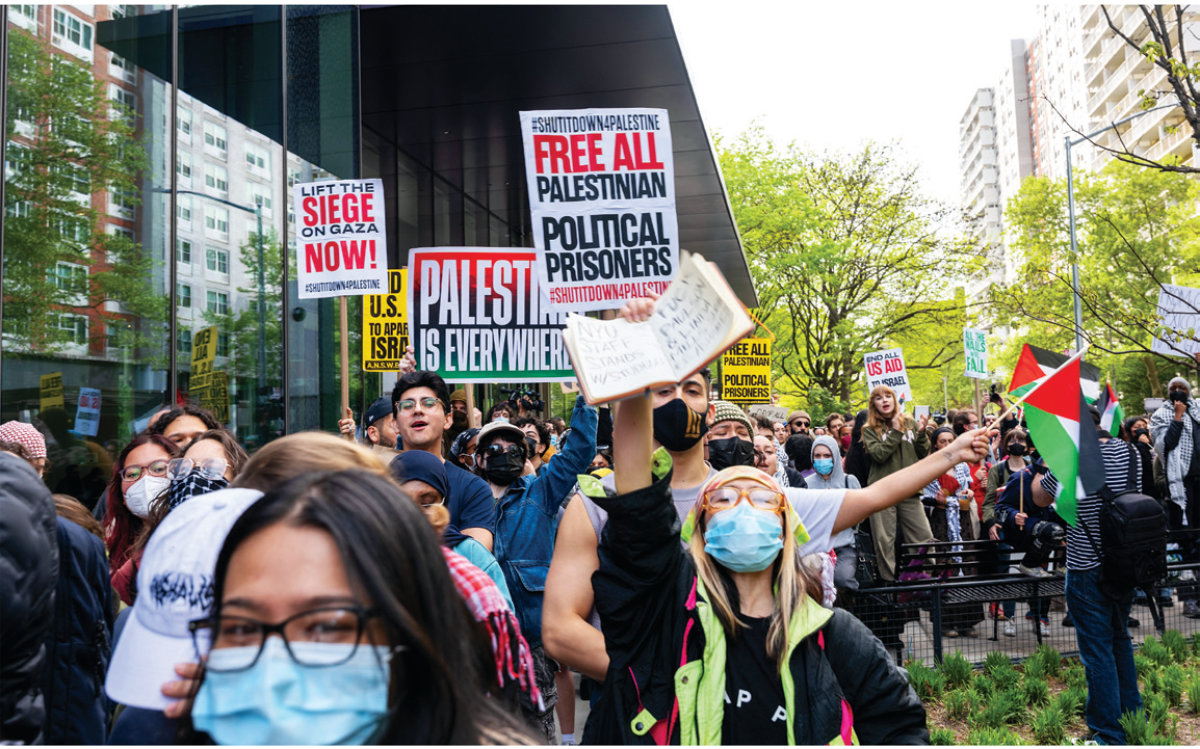
If there is an answer, Segal concluded, “it will require abandoning the defunct Oslo paradigm, which sees Palestinian statehood emerging as a result of successful end-of-conflict negotiations.
“The alternative is a sovereignty-in-Gaza-first approach, to test Palestinian statehood in Gaza first and, only if it is successful over an agreed period, to then move to negotiations on extending Palestinian sovereignty to the West Bank.”
Right now, Segal’s dogged commitment to the peace process is as admirable as it is remarkable.
But, in the face of a general lack of alternative proposals, it perhaps also offers the best hope of achieving Clinton’s wish, expressed on the White House lawn over 30 years ago, that “two peoples who have both known the bitterness of exile” might “put old sorrows and antagonisms behind them ... to work for a shared future shaped by the values of the Torah, the Qur’an, and the Bible.”




